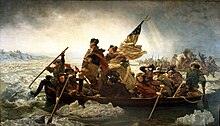The Pennsylvania Portal Pennsylvania (/ˌpɛnsɪlˈveɪniə/ , lit. 'Penn's forest country'), officially the Commonwealth of Pennsylvania (Pennsylvania Dutch: Pennsylvanie), is a state spanning the Mid-Atlantic, Northeastern, Appalachian, and Great Lakes regions of the United States. Pennsylvania borders Delaware to its southeast, Maryland to its south, West Virginia to its southwest, Ohio and the Ohio River to its west, Lake Erie and New York to its north, the Delaware River and New Jersey to its east, and the Canadian province of Ontario to its northwest. Pennsylvania was founded in 1681 through a royal land grant to William Penn, the son of the state's namesake. Prior to that, between 1638 and 1655, a southeast portion of the state was part of New Sweden, a Swedish Empire colony. Established as a haven for religious and political tolerance, the colonial-era Province of Pennsylvania was known for its relatively peaceful relations with native tribes, innovative government system, and religious pluralism. Pennsylvania played a vital and historic role in the American Revolution and the ultimately successful quest for independence from the British Empire, hosting the First and Second Continental Congress leading to the adoption of the Declaration of Independence. On December 12, 1787, Pennsylvania became the second state to ratify the U.S. Constitution. The bloodiest battle of the American Civil War, at Gettysburg over three days in July 1863, proved the war's turning point, leading to the Union's preservation. Throughout the late 19th and 20th centuries, the state's manufacturing-based economy contributed to the development of much of the nation's early infrastructure, including key bridges, skyscrapers, and military hardware used in U.S.-led victories in World War I, World War II, and the Cold War. Pennsylvania's geography is highly diverse. The Appalachian Mountains run through the center of the state; the Allegheny and Pocono mountains span much of Northeastern Pennsylvania; close to 60% of the state is forested. While it has only 140 miles (225 km) of waterfront along Lake Erie and the Delaware River, Pennsylvania has the most navigable rivers of any state in the nation, including the Allegheny, Delaware, Genesee, Ohio, Schuylkill, Susquehanna, and others. (Full article...) This is a Featured article, which represents some of the best content on English Wikipedia..
Samuel Jackson Randall (October 10, 1828 – April 13, 1890) was an American politician from Pennsylvania who represented the Queen Village, Society Hill, and Northern Liberties neighborhoods of Philadelphia from 1863 to 1890 and served as the 29th speaker of the United States House of Representatives from 1876 to 1881. He was a contender for the Democratic Party nomination for President of the United States in 1880 and 1884. Born in Philadelphia to a family active in Whig politics, Randall shifted to the Democratic Party after the Whigs' demise. His rise in politics began in the 1850s with election to the Philadelphia Common Council and then to the Pennsylvania State Senate for the 1st district. Randall served in a Union cavalry unit in the American Civil War before winning a seat in the federal House of Representatives in 1862. He was re-elected every two years thereafter until his death. The representative of an industrial region, Randall became known as a staunch defender of protective tariffs designed to assist domestic producers of manufactured goods. While often siding with Republicans on tariff issues, he differed with them in his resistance to Reconstruction and the growth of federal power. (Full article...)Selected geography article -Plunketts Creek is an approximately 6.2-mile-long (10 km) tributary of Loyalsock Creek in Lycoming and Sullivan counties in the U.S. state of Pennsylvania. Two unincorporated villages and a hamlet are on the creek, and its watershed drains 23.6 square miles (61 km2) in parts of five townships. The creek is a part of the Chesapeake Bay drainage basin via Loyalsock Creek and the West Branch Susquehanna and Susquehanna Rivers. Plunketts Creek's name comes from the first owner of the land including the creek's mouth, and the creek has given its name to two townships (although one has since changed its name). The creek flows southwest and then south through the dissected Allegheny Plateau, through rock from the Mississippian sub-period and Devonian period. Much of the Plunketts Creek valley is composed of various glacial deposits, chiefly alluvium. (Full article...)Selected image - Credit: Kev72 Downtown Harrisburg and the Pennsylvania State Capitol Building as seen from Cumberland County, across the Susquehanna River. Did you know -
Related portalsWikiprojectsThis is a Good article, an article that meets a core set of high editorial standards.
George Washington's crossing of the Delaware River, which occurred on the night of December 25–26, 1776 during the American Revolutionary War, was the first move in a complex and surprise military maneuver and attack organized by George Washington, the commander-in-chief of the Continental Army, which culminated in their attack on Hessian forces garrisoned at Trenton. The Hessians were German mercenaries hired by the British. Washington and his troops successfully attacked the Hessian forces in the Battle of Trenton on the morning of December 26, 1776. The military campaign was organized in great secrecy by Washington, who led a column of Continental Army troops from today's Bucks County, Pennsylvania across the icy Delaware River to today's Mercer County, New Jersey in what was one of the Revolutionary War's most logistically challenging and dangerous clandestine operations. (Full article...)Selected article -Arnold Daniel Palmer (September 10, 1929 – September 25, 2016) was an American professional golfer who is widely regarded as one of the greatest and most charismatic players in the sport's history. Dating back to 1955, he won numerous events on both the PGA Tour and the circuit now known as PGA Tour Champions. Nicknamed "The King", Palmer was one of golf's most popular stars and seen as a trailblazer, the first superstar of the sport's television age, which began in the 1950s. Palmer's social impact on golf was unrivaled among fellow professionals; his modest origins and plain-spoken popularity helped change the perception of golf from an elite, upper-class pastime of private clubs to a more populist sport accessible to middle and working classes via public courses. Palmer, Jack Nicklaus, and Gary Player were "The Big Three" in golf during the 1960s; they are credited with popularizing and commercializing the sport around the world. (Full article...)Pennsylvania news
CategoriesState factsState Facts
State symbols
Pennsylvania topicsGeneral imagesThe following are images from various Pennsylvania-related articles on Wikipedia.
Associated WikimediaThe following Wikimedia Foundation sister projects provide more on this subject:
Discover Wikipedia using portals |

































































